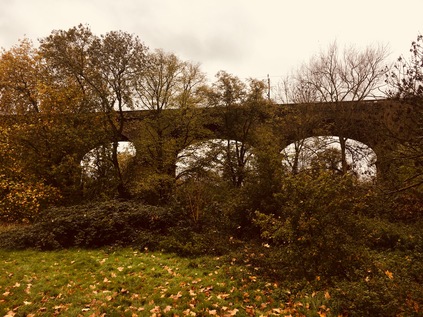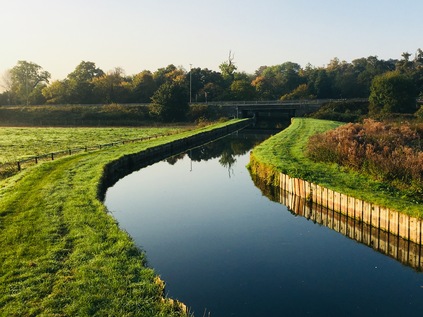It's a long time since I've set off aimlessly on a train, just for the hell of it. These odd days between Christmas and New Year have, traditionally, been an ideal time for this however - peak fares relaxed, trains quiet, and little else to do has meant I've often disappeared around the network on some sort of largely unplanned excursion. On a few occasions I've picked up one of the more local Rover tickets and spent a few days zipping around the local lines which I'd generally neglected in favour of more exotic trips during the year. In short, until I curtailed my rail-borne activities a few years back, this had been a time to escape from the sense of ennui and restriction which the festive season often brought with it.
Times change, and life here certainly has - but this year I found myself with three days off between Christmas and our new year trip. The house was empty save for me and two very sleepy cats, and so somewhere during the first day or so I realised I'd very swiftly finished the run of little jobs I'd assigned for myself and was twiddling my thumbs. Too restless to read, I began to think about a trip - and one immediately suggested itself. I'd wander up to Bristol to have a look at the stock move bringing a short rake of former Virgin 'pretendolino' carriages north to Crewe in preparation for a contractual-obligation run on New Year's Eve, then I'd try to get a first ride on one of the new Class 800 trains operating on the Great Western Main Line. If I could squeeze in a trip on one of the not-even-nearly-new Class 166s which have now been handed down to be used in the West, that would mean I hadn't completed the year without experiencing the changes on the network in my local area at least... I was slipping - my wife had already had one of her commutes on a Class 800 - but maybe I could catch up?
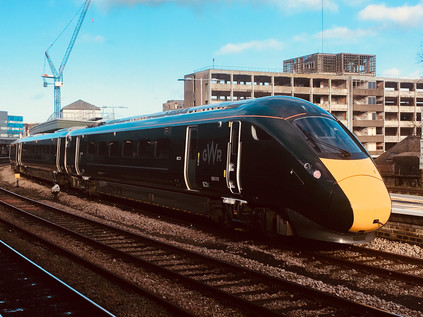
I didn't decide I was definitely heading out until this morning, and I did so in such haste that I set off earlier than needed. My journey to Bristol was on tidy and freshly green-vinyled 150244, which was also rather well refurbished inside with wifi, sockets and USB points throughout. It was a bright, cold morning - a good time to be out and about - and so I settled in for a long, chilly wait at Temple Meads with coffee. It was, in some ways just like the old days. My over-eager start meant quite a considerable fester on the platform, and I began to feel conspicuous as I wandered around to keep warm and see what was happening. There was a time I'd have been confident enough that I was well-known to not care too much, or would at least have felt like I was acting less furtively. I also realised that I'd not brought a proper camera, so the passage of the convoy from Laira to Crewe wouldn't get recorded. As it happened, low winter sun from the south west filled the cutting just before the moment of arrival, and any picture would have been a challenge. A few moments early, 57303 led 37059 rather ponderously through the station with four gleaming silver coaches in tow. I understand that these coaches have yet to be converted electrically for use with the Class 68 locos which will haul them - so anyone who does brave the short 'unadvertised' working between Manchester Airport and Manchester Piccadilly on New Years Eve will be very cold indeed!
During my wait, a pair of Class 800s had silently crept into Platform 13 and waited to form the 13:30 departure. The various published diagrams for these new trains have gone to pot due to the holidays, slow progress in driver training and initial teething troubles - so I hoped this cycle would repeat on the 14:30, which I planned to catch as far as Swindon. I was curious to try the Class 800 for a number of reasons - not least because the Great Western Main Line is one of the few routes I use regularly, and my comfortable and relaxing trips to London have become an essential part of keeping me on the straight and narrow in recent years. I wanted to know how the trip would feel in future, and how to navigate the new trains. I also wanted to acknowledge the beginning of an important transition - the High Speed Train has been such a feature of my travels over the last few decades that I almost can't believe we'll see the end of it here sooner than elsewhere. The Class 800s have earned derision for the Department for Transport, for GWR and for Hitachi due to teething troubles - but how often has any new stock arrived which hasn't struggled at first? I wanted to make my own mind up - from the point of view of a traveller as well as an enthusiast - which is sometimes a challenging shift to achieve.
But, it wasn't to be... I was relieved to get off the wedged HST I took out to Swindon, stepping over students lurking in the vestibule rather than taking seats which meant sitting next to other punters. Perhaps they did this in some sort of tribute to Jeremy Corbyn's own vestibular antics? Swindon station hadn't changed - a long windy platform with a tired and sleepy buffet on the platform and a deserted WH Smiths concession. I crossed to the newer Platform 4 and lurked in the warm of the long waiting room, popping out for each westbound train as it was due. Each one was a HST - with the parade of Class 800s which had passed towards Bristol regularly passing the other platform. I had one more opportunity before I needed to be back at Bristol - and yet again, it was a HST. I settled into the warm seat, put on my headphones and relaxed into the journey - it was good to be out and about as the sun sank behind the rolling Wiltshire scenery. It had been a good day - a reminder that even when I'd meticulously planned things in the past, they'd sometimes not worked out. I reminded myself that it was all a little like fishing - and sometimes you didn't get a bite...
Back at Bristol, I headed for the Taunton-bound train my wife was catching home from work, shuffling along with the trickle of unfortunate commuters working in these strange days between the holidays. I thought of the trip we were taking in a few days and of the excursions to London I'd already planned - the adventures have changed a little, and now they're ours rather than just mine. When the time comes, I'll be interested to try out the new trains - but I know I'll miss the smell of hot brake pads and the slamming doors of the HSTs...
...and the train home wasn't a Class 166 either!
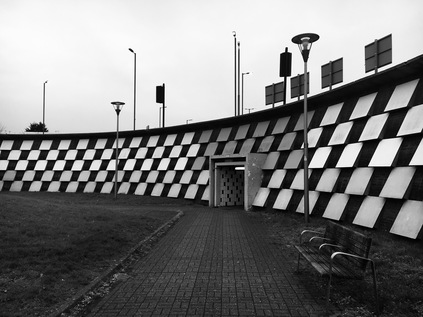
London's Other Orbitals: The A5109 & A109 - A Middlesex Arc
Posted in London on Saturday 2nd December 2017 at 11:12pm
When I wrote a somewhat belated introduction to my series of London's Other Orbital walks, I perhaps played down just how obsessively fascinated with roads I was as a child. For a chubby, shy and relentlessly bullied boy from the Midlands, getting home from school and being able to pore over maps of blue, red and green lines snaking over the country was my escape. The journey home itself was a fantasy world of civil engineering projects and complex interchanges, as I imagined each side-path into a housing estate as a motorway junction along my walk. I drew endless networks - sometimes imaginary, sometimes improvements to the tangled and congested junctions on the maps. I internalised an intimate understanding of the complex and sometimes apparently arbitrary numbering system which had landed on the maps in 1922 and had almost immediately been littered with exceptions and compromises. In short, I was a strange and introverted boy who preferred the company of maps to other people. To some extent, I'm just a slightly better socially-adjusted version of that same youngster nowadays. The gift of a map is always a delight as friends and family know - but they can then expect to lose me for hours. When I finally moved the last of my possessions out of my parents home in preparation for its sale, I uncovered a stash of ageing maps: huge single-sheet Bartholomew road maps were tucked into the queasy golden-brown cover of an early 1970s AA Book of the Road, with its magical strip-maps of motorways, some represented by thick dashed lines and still yet to be built. Indeed, some never were built. Growing up to be a non-driver isn't, as many who offer me unwanted advice seem to assume, a great source of regret - I truly haven't the right skills to do it safely or without undue stress - but it does mean that my experience of the road network is a little different. Writing about the routes which slink across London, between the mighty arterials which pulse traffic into the city's core, has been revelatory: I've simultaneously discovered how well I know the suburbs and how little I know of them. When arriving at a familiar junction from a new direction, the world fits together a little better, but new arms on the sign become fresh mysteries.
Why the introspection? This is likely the last of these proto-orbitals north of the Thames. There are other roads to walk, and I hope to get to those on future trips, but none of them conforms to the admittedly loose brief I set myself with this project. Indeed this walk was a little contrived in itself - the A5109 and the A109 have never really been one route - but there is some evidence that this arc of tarmac which starts at Mill Hill and manages to break out of the gravity of urban London before descending from the heights into the Lea Valley at Edmonton has been used to skirt the northern suburbs for time immemorial. It has the well-worn feel of a country lane for much of its length - a road which has always been there perhaps? It certainly begins its journey on an ancient trackway - and I began my walk there too, under threatening grey skies at the crossroads where Edgware straddles the venerable course of Watling Street on its journey from Dover to Anglesey. The modern junction is a textbook London suburban centre - a vast mid-century pub, The Masons Arms, takes up an entire corner while a range of red-brick shopfronts and a run of mock-Tudor cottages heads north. The businesses on this busy intersection are low-key, unloved and apparently not well-patronised on Saturday mornings. I turned south on the A5, enjoying the surprisingly long view offered by the altitude and the straight carriageway. Modern Edgware, away from the bustle of its small urban centre at least, is a little grey and down-at-heel. The road is flanked by uninhabited office blocks, business centres and building suppliers, a landscape without people - which makes those walking beside the road strange and threatening. It's not hard to fit this into the narrative of Dick Turpin, the celebrated highwayman who was perhaps not the heroic character which has been passed through the purifying flame of nostalgia - his gang's raid on Earlsbury Farm in Edgware in February 1735 saw Joseph Lawrence, a man of seventy, tortured, stripped and burned while his servant girl was raped. Edgware still feels like the place where a blind eye would be turned, where people would thank their lucky stars it wasn't them and hurry away. This may be uncharitable - but trudging along the lonely and brooding dark channel of the A5 did not inspire much faith in humanity today.
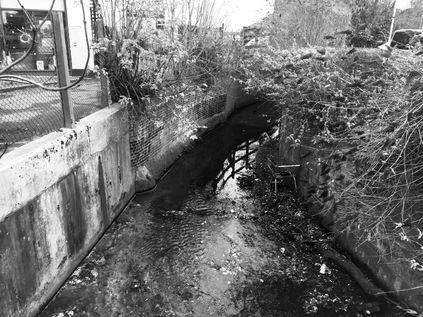
This short stretch of Watling Street did however take me over the Edgware Brook, a filthy and rather noisome stream which curved under the road in a concrete culvert near to the junction where the A5109 turned east - and where my walk began in earnest. The rise of the road as I headed into the suburbs indicated that I was heading for the higher ground where the headwaters of the River Brent rise and that I'd be crossing numerous tributaries which snaked together to form the Silk Stream and the Dollis Brook, converging at a point I'd passed on a previous walk. It was hard to read this suburban climb as an A-road at all as it slowly ambled between pleasant inter-war semi-detached homes. Deansbrook Road rose gently towards the bridge which carries it above the Northern Line on its final stretch towards Edgware and the watercourse for which it is named. The Deans Brook rises on the high ground of Scratch Wood, taking in the waters of the Edgwarebury Brook, the Edgware Brook and the Burnt Oak Brook before becoming the Silk Stream near Burnt Oak Station. A footpath descended to snake briefly alongside the brook before passing between the houses below, but it wouldn't have taken me further along my route. Instead, I followed the road to its first junction, an unremarkable suburban roundabout where it turned illogically north to skirt the edge of Mill Hill. The road climbed again and began to curve towards the east, with the impressive hulk of John Keble Church gradually revealed ahead - first the golden brick of the tower, then the stepping bulk of its nave. Designed by D.F.Martin-Smith, the church was consecrated in 1936 and Grade II listed in 1989, the slender louvred tower dominated the view uphill with Keble's name inscribed in stone above a stylised eagle - emblematic of a poem in his Christian Year. Reportedly, this is the only church dedicated to Keble, the humble but influential poet-vicar who formed part of the Oxford Movement. It sits on this rather inconsequential spot, a formative step in modern church building. In 1958, Martin-Smith, then in partnership with Henry Braddock went on to build the swooping brick and concrete St. Mary's in Crawley - a more ambitious and challenging building, but perhaps one that sits less comfortably in its surroundings than this arresting hilltop structure?
The road continued to head northeast, passing through the rather drab shopping zone at The Hale - one of the several knots of urban life which make up Mill Hill. There is no real centre to this suburb, in part due to the haphazard railway development which saw a single-track line from Finsbury Park to Edgware opening in 1867 with the plan to expand when traffic grew. In the event, the High Barnet branch was much more profitable and the second track was never laid. The line languished on with a shuttle service to Finchley until 1935 when the London Passenger Transport Board's New Works Programme proposed to link the suburban lines from Finsbury Park into the Northern Line and to use a long-established right to build rails beyond Edgware to Bushey Heath. The complex web of Northern Heights lines would thus feed into the branches of the Northern Line, and would link the suburbs to the city - but the war intervened, and little was achieved beyond electrification to Mill Hill East. The line beyond this was abandoned and now provides a TfL supplies depot, a nature reserve and an intermittent and somewhat forlorn greenway between Edgware and Mill Hill. Beyond The Hale, the road climbed steadily to another of Mill Hill's scattered urban loci at Apex Corner. The origin of the curious name for this spot appears lost in history, but likely refers to its relative elevation and the meeting of the roads to Watford and Barnet. The modern incarnation of the junction sees the A1 and A41 sweep in from the south as a single, wide road before dividing at the roundabout and heading in their respective directions. Meanwhile, just feet from the roundabout and entirely disconnected from this earlier incarnation of the trunk road network, the M1 thunders in a cutting alongside the Midland Mainline to St. Pancras. By the early 1960s, the junction had acquired its current configuration, swirling around a sunken pedestrian area with a tiled bank of chequerboard stone raking up to the road and solid stone portals providing access to the radiating footways. At some point, Apex Corner must have been a busier spot for walkers, but now the junction is a bleak prospect on foot. While one corner retains a typical suburban retail parade now operating the ubiquitous mix of betting, tanning and eating establishments, housing has largely encroached elsewhere. But on the northern flank, between the arms of the roundabout which stretch out to Watford and points north, a drive-thru KFC and a Shell filling station provide necessary services to those who are sticking to the old routes. Apex Corner is the ghost of a staging post on the road north, and while traffic rumbles north on the nearby motorway, this oddly bleak circus sits on its hilltop looking beyond London.
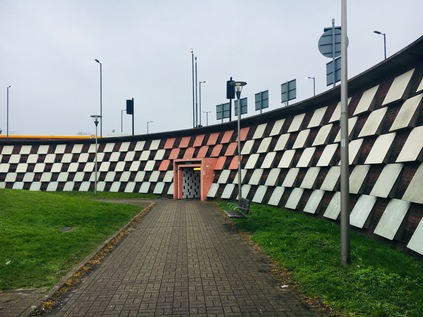
My route was briefly with the A1, before the A5109 turned northeast at an awkward afterthought of a divergence, necessitating traffic skittling across the central reservation after being freed of the gravity of Apex Corner. The main road continued north, a silvery ribbon of tarmac heading out of the suburbs and rising into the greenbelt which curtailed London, allowing the green spaces of Scratch Wood and Moat Mount to remain undeveloped. The scene reminded me of the vintage 1980s logo adopted by the London Borough of Barnet, featuring a sweep of dual-carriageway snaking around oversized trees. The woods here were once threatened by the semi-mythical Stirling Corner Link - a road joining the M1 and the A1, and the first chance for northbound traffic to leave the motorway at Junction 3. This junction was never completed, with three-quarters of a roundabout forming awkward access to London Gateway Services instead. The road, if built, would have carved through the top of Scratch Wood, sending sliproads arcing over the A1 and descending into Thistle Wood in at least one version of the scheme. The planned Junction 3 was part of the 1961 plan for the M1 which had it ploughing on to Marble Arch, unhindered by anything in its path. The more modest Hendon Urban Motorway opened in 1967 without Junction 3 and sputtered to a premature halt near Fiveways Corner rather than relentlessly progressing into the West End. Various references in the National Archives to soil slippage at Scratchwood and expensive remedies needed for shifting concrete walls along this section of the route may give a clue to why this was the case. However, the plans remained resolutely part of the future development of the motorway until being quietly shelved in the straightened public spending round of 1976. The link road concept has resurfaced at times, not least in 1989 as part of the Roads for Prosperity plans - getting as far as an invitation for prospective builders to tender on that occasion. But in 1994, the plan was finally killed for good, and the services continue to delight in the most bizarre and confusing access routes in the land. The green spaces remain, quiet and undisturbed - at least for now...and I was soon to find myself practically out in the country, despite being firmly within the confines of Greater London.
There was a distinct shift as the road climbed Highwood Hill - suburban semis became large villas and gated dwellings of impressive scale, and the cars outside properties were newer and far fancier. At the peak of this first climb, the pavement switched sides, the first of a number of times I'd need to cross the A5109 as it became essentially a country lane. This rural byway however saw traffic at North London speeds and densities and even had a regular service of red double-decker buses. This was an indication that my sloppy categorisation had been accurate - this was an orbital route in the same way that some of its more impressively proportioned relatives further south were being used - the most direct route from somewhere to somewhere else, even if not the officially sanctioned means of crossing London. Satellite navigation has changed behaviour here, and the most direct route is suddenly open to even those who don't know the terrain. You can detect them - barrelling into corners and shifting gears erratically to scale hills, but utterly unaware of what lies beyond. They trust the instincts of the machine, and mostly it works out for them - and so they continue until they're let down by the technology in some dead-end. Even then, they'll usually allow the algorithm to re-route them out of trouble. Highwood Hill was an exclusive address as early as 1825 when Sir Stamford Raffles, fresh from his colonial exploits in Singapore and the Far East returned to live out his last days here. While Raffles was a proponent of colonial reform, his ideas were perhaps not entirely in tune with the great reformer and supporter of emancipation William Wilberforce, who retired to his own property nearby just a year later. In declining health and having retired from Parliament, he survived long enough to see his campaigning result in the final Commons reading of the Abolition of Slavery Act in 1833. At the crest of the hill, between the sites of these two gentlemen of the Regency era, Nan Clark's Lane leads north into the fields - marking a final retreat of an entirely other nature. Nan Clark was a barmaid in The Rising Sun with many admirers but wed to an exceptionally jealous husband. When rumours of an affair reached him, he is reputed to have dragged her by the hair along the lane to a lake where he drowned her in front of a horrified audience who had followed them from Highwood Hill. The legend has spawned a range of stories of supernatural goings-on which are sadly the only record of Nan Clark now. Fuelled by the presence of the lane and with The Rising Sun still trading nearby the legend is a popular local ghost tale that adds a slight frisson of the rural English gothic to the estate agents patter when they're flogging property on the overheated market in NW7.
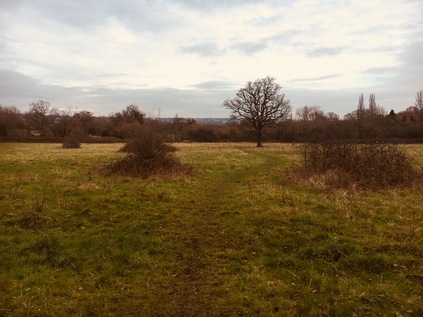
Shortly after reaching the peak of the hill both pavements gave up completely, the road narrowing and curving menacingly into the next rise. Relying on my map, I headed through a gate and into Totteridge Fields. This local nature reserve is perhaps not at its best in December, but the faint sunshine and the glorious sweep of ungoverned green was a welcome relief from the road. I squelched diagonally across the former hay-fields, which narrowly escaped conversion into a cemetery in the early 1990s and which are now leased by Barnet Council to the London Wildlife Trust. Aside from a well-kept information board and some sturdy kissing gates, they've left the land to run wild and the desire-line I followed was ghosted by the skeletons of autumnal weeds and wildflowers bending in the breeze. At the edge of the field, I crossed a tiny brook by way of a wooden bridge, realising that this was one of the barely trickling sources of the River Brent which had seemed such a broad and mighty presence on my last walk. Here I could press onwards to find the London Loop which meandered along with the nascent Dollis Brook nearby, or I could double back towards Totteridge and the road. I felt duty-bound to do the latter, and after scrambling over a muddy stile worked my way up an indistinct footpath lined with frequent dire warnings not to stray. The waterlogged scramble eventually brought me to a drive between two impressive farmhouses, and then back to the road. This was Totteridge - a long, straggling village set in former Manorial lands now in trust to a private association. Each house, set back and discreetly screened from the road, bore its name on a curved, white painted stake on the road. A footpath was tolerated but often ill-kept and ruptured by ancient roots. No-one walked this stretch - it was too important to be seen in the right kind of motor car, cruising by the long ponds which lined the southern flank of the road. Nothing interesting was happening here, and everything was just so - the Manor's groundskeepers ensuring that the carefully preserved and jealously guarded lack of event was undisturbed. The scenery was green and pleasant, but I must confess utterly dull and surprisingly charmless. The road curved and descended a little towards the Dollis Valley and a few fellow walkers appeared, surveying my muddy and leaf-caked boots with disdain and alarm. They headed for The Orange Tree, a vast rural pub with a well-stocked car park and an enviable menu of gastropub delights near the edge of Totteridge. Eventually, at the foot of the hill, I found the anonymous parapet where the Dollis Brook headed under the road on route to Welsh Harp. The footpath into Whetstone Stray, alongside the churning waters which had already gathered some surprising pace and width since I'd seen their tiny tributary a mile or so back, was tempting - but the road needed to be walked to its conclusion. Up ahead, the A5109 shuddered to a halt at a staggered crossroads not far from Totteridge and Whetstone station. This little knot of urban normality felt like a relief after the forced conservation of Totteridge. As I navigated around an angrily accelerating driver who was hot on my heels as I completed my crossing of the road, I didn't spot the Whetstone until I had passed by. This stone of unknown origin appears to have been used as a mounting block beside the tollgate which controlled access to the Whetstone and Highgate Turnpike here until 1863.
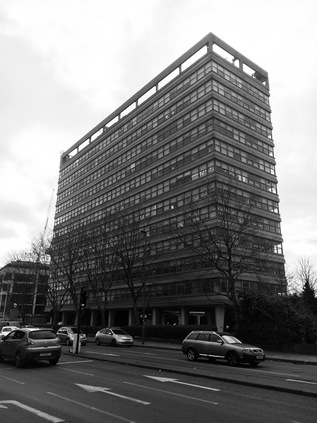
On the corner where the A5109 meets the former Great North Road stood Eveready House - now known as Barnet House, a strikingly modern block built in 1966 by Richard Seifert for the British arm of the Eveready battery company. Gravity-defyingly bulky, the building stands on pleasingly solid-looking stilts above the ground. Seifert's almost impossibly prolific output in London alone produced such a mix of wonderful, terrible and downright ordinary buildings that it is hard to approach preservation of his heritage - however, as the building was adopted by Barnet Council in 1986 its recent fortunes have remained fairly assured. It is difficult to imagine how such a substantial block this far out of the city could survive for long without this public patronage, however. My next stretch of road departed the former A1 route directly opposite the building, the surprising suburban bulk glowering over the rather innocuous beginning of the A109. This road has always been numbered thus, unlike the A5109 which was until the 1940s a lowly B-road - but it has a sort of deferential air, giving way to other roads and allowing them precedence at junctions. The A109 comes into its own for just the kind of local in-the-know traveller I've talked about before - for whom the journey across and within the city is more important than simply getting to or from London. The village centre of Whetstone clung to the road for a spell, allowing me to find some much-needed sustenance - it had been quite a hike up from Edgware and I was wondering if I'd set myself a challenging walk in the time available today. I rested briefly on a damp bench among a disarmingly constant stream of pedestrians - it felt like I'd been largely alone for much of the morning, and needing to weave around people was an odd new feeling. I set off again, heading downhill now with surprisingly good views to the east. This was the largely unremarked suburb of Oakleigh Park, lining the route with pleasant, suburban homes which for a decade from 1941 housed a secret listening station for the Soviet news agency, TASS. The plug appeared to be pulled by the Security Services in 1951, but only after Barnet Council had unsuccessfully tried to close the station on planning grounds. The road continued south, bridging the railway at an awkward angle before running alongside it towards the city. The sliver of land to the west of the road was hemmed in by the tracks, and when it finally became broad enough to be useful hosted a string of industrial units and building suppliers. The road was quiet here - there are lots of better ways of getting across town nearby and the A109 is left to its rather forlorn own devices. Only buses and the occasional white van heading for one of the local businesses passed me as I trudged on into a purple, brooding sky. It felt like the night was already encroaching and I fell into a reflective frame of mind as I walked south, thinking about how this route was now converging with other walks: the valley of Pymmes Brook ran parallel close by to the east, and I was once again converging with the North Circular on its relentless arc. These northern zones which once seemed so unreadably vast and dull were becoming strikingly familiar in parts but still maintained a capacity to surprise me with a sudden view or diversion.
The A109 began to climb again near New Southgate Recreation Ground, part of a swathe of green space which stretched north to the Pymmes Brook valley and Brunswick Park, crossing the spoked wheel arrangement of the cemetery. This site - then known as the Great Northern Cemetery - would have been the first to offer cremation in the UK in 1861 had the Bishop of Rochester in whose diocese large parts of suburban North London still sat, not replied that he had neither the will "nor the power to allow such a mode of disposal of the bodies of the dead". The Cremation Society persisted in its efforts, and finally, the first cremation of the modern era took place in 1885. The Cremation Act followed, passed in 1902 to authorise burial authorities to establish crematoria but also to outlaw open pyres like that used by the self-ordained Druid Dr. William Price to dispose of the body of a child fathered to his housekeeper. At the peak of the rise, the A109 again deferred to other roads at the oddly named Betstyle Circus. This little urban cluster in the suburbs seems confused - either masquerading as Friern Barnet or New Southgate and with the boroughs of Barnet and Enfield erratically switching territory around the spokes of the roundabout. My route unexpectedly took the easterly exit here, before swiftly turning south again to pass by New Southgate station. Across the rails and above the trees the impressive buildings of Friern Hospital could be seen, formerly the Middlesex County Asylum and now an exclusive housing complex. The boundary of the boroughs edged along the railway here, with the road falling into step beside both until it dog-legged to the east to skirt the site of the former New Southgate Gasworks, now given over to a vast builders trade supply business which sat atop the arches of the railway siding which once served the site. The single remaining gasholder reminded me I was approaching the North Circular once again, and encountering a familiar view from a different direction. A new development of apartments was slowly rising beside the pavement here, wedged into the corner created by the A109 and the Bounds Green Brook. The hiss and shudder of the busiest road I'd encountered since leaving Edgware was evident before I could even see it stretching along the valley floor, bisecting my onward route which climbed the valley ahead of me. I had no business with the A406 today, but I did need to cross the six lanes of traffic here. The crossing had an entirely different impact approaching from the north, and the road felt more like an imposition on the landscape from this aspect. As I waited for the lights to change, the sole pedestrian in sight I supposed, I noted a small group huddled on the central island. Occasionally when a stream of traffic braked hard for a red light, they would groan and rise, tottering at first on uncertain legs, before working the stream of cars. Some, the most downtrodden and disabled among them, would beg in the most direct sense. Meanwhile, a more enterprising younger man in a hi-vis vest he'd probably retrieved from the verge of the road sold multipack cans of Diet Coke and bottles of water from a shopping basket. This probably worked well in a summer traffic jam, but on a grim December afternoon when snow threatened, drivers seemed less inclined to buy. As the lights changed and I crossed, the forlorn group repositioned to ply the next queue of traffic. I hadn't noticed these people when I made my way along the North Circular. Had they been there, and my onward focus too unwavering to miss them? Or had they been obscured by others using the crossing that day? For all that's said about my introversion and self-absorption - especially when I'm walking - I'd hope that I wouldn't have overlooked such a sorry scene taking place in the midst of this unsheltered tarmac plain? I completed my crossing and began walking up the hill which climbed out of the valley of the Bounds Green Brook. Looking back, the figures were only barely visible, scuttling and hobbling towards cars in a display of surprising optimism each time the lights changed.
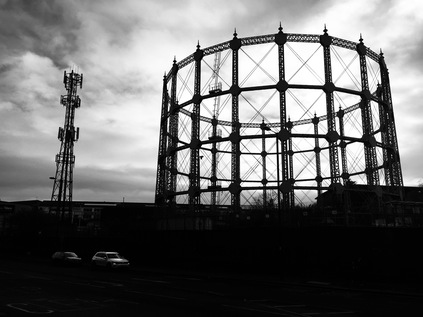
It was possible to walk along a surprisingly broad area of green space beside Bounds Green Road, which rather reminded me of its appearance on early maps of Middlesex as a country lane in a wooded channel between the fields. Suburbia had encroached by the late 19th century, with Wood Green sprawling inexorably towards Southgate as Londoners moved out of the city along the railways. Bounds Green however seems to have stayed surprisingly upmarket, with many fine old houses ranged along the terraces beside the road. Not all remains of course, and around the twin brick towers of Newbury House and Finsbury House is a small estate of modern, low-rise housing which feels a little unloved and in need of refurbishment. Nearby, in surprising contrast is the red-brick and white stone Braemar Avenue Baptist Church, an unusually decorative approach to a non-conformist chapel and a reminder that Wood Green and Tottenham were hotbeds of religious dissent. The congregation relocated to this fine building in 1907, having previously assembled in a range of homes and halls across the area. I'd encountered the church during my walk along the New River Path, and I soon crossed the route of the river's tunnel which meant I was closing in on Wood Green. One last surprise before I plunged into the urban maelstrom of 'The Mall' was the obelisk dedicated to Mrs Catherine Smithies which sits on a patch of ground outside a rather gentrified run of shops and pubs. Smithies was responsible for the formation of the Band of Mercy - an organisation that aimed to teach children kindness and humanity to animals in the hope of creating a future world peopled by peaceful adults. Smithies modelled her new organisation on the Band of Hope temperance movement initiated by the Baptist minister Reverend Jabez Tuncliffe in Leeds. By the end of the century, the RSPCA assumed responsibility for the Band of Mercy movement, though it continued to grow in strength in the United States through the work of George T. Angell who restated the organisations aims to:
[...] teach and lead every child and older person to seize every opportunity to say a kind word or do a kind act that will make some other human being or some dumb creature happier.It felt rather odd to see Wood Green as a cradle of kindness and religious diligence as I approached a crossing the High Road. The flank of Haringey Civic Centre with its pleasing brick and stone lines betraying its origins in the late 1950s. From the rear, a dramatic wing of the building strode out across the car park on stilts with metal stairs elbowing into view, partially obscured by St. Michael's Church. A little further along the street, the Fishmongers Arms was a reminder of the Fishmongers and Poulterers Almshouses which occupied this site before it was a seat of Local Government. I crossed the street near the rather drab little scrap of park dedicated to King George VI which had been occupied by a dedicated drinking school on my last visit. Today it was empty, the cold weather and the stream of pedestrians heading for their festive retail destinations driving out the locals. I turned towards Wood Green with some trepidation...
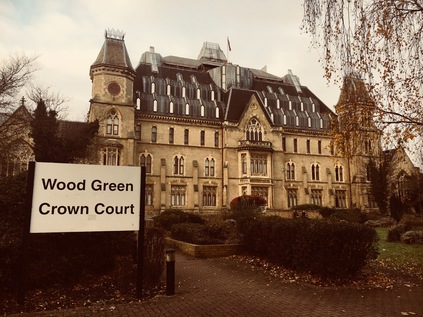
I wasn't sorry to make the turning into Lordship Lane near Wood Green Underground Station. The pavements were impassably busy, with people darting between streams of travellers emerging from the tunnels and some testy exchanges as they cannoned into each other in their haste. Pedestrians were laden with bags or staring into electronic devices, always too occupied to focus on their surroundings - and it struck me that I was the only person in this strange little urban swirl who was walking for the sake of the act. No wonder I was regarded oddly, my boots and trousers marked by dried-on Middlesex earth and my face masked by a scarf against the cold and fumes. A little south of here, somewhere under the massive brick ziggurat of Wood Green's mall, was the site of Alderman's Bridge where the River Moselle passed under Green Lanes and formed the edge of the building plots on the southern side of Lordship Lane. The road quickly reverted to suburbia, leaving the chaos of the shopping centre behind. However, the rather uniform buildings suddenly gave way to the somewhat bizarre Wood Green Crown Court building. Originally built as the Royal Masonic School for Boys, supporting the children of deceased and poor Freemasons, the building remained as a place of education until the 1930s when it was acquired by the Tottenham and District Gas Company and renamed Woodall House in honour of Sir Corbet Woodall, former chairman of the Imperial Gas Light and Coke company who is commemorated by a statue now at Twelvetrees Crescent in Bow. After nationalisation in 1948, the building found use as the headquarters of the Eastern Gas Board. In 1974 it was acquired by the Borough of Haringey and modernised to become Wood Green Crown Court and Remand Centre. The building's current appearance, with a dramatic and somewhat strangely mountainous roof filling the gap between the tower on each flank dates from rebuilding after an arson attack in 1989. The Court continues to find new ways of remaining in the public consciousness too - seeing Britain's first juror jailed for using the internet in contempt of court in 2013. Today, all was quiet outside the building except for a group of drinkers loudly discoursing in the garden - I couldn't help but wonder if they were the displaced group from King George VI Gardens, relocated to a more exclusive spot to avoid the crowds. Perhaps they are part of the civic fabric of Haringey?
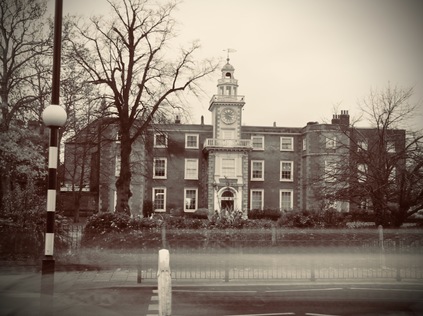
I continued to head east, aware of the Moselle's hidden course nearby, recalled in the street names if nowhere else. I remembered my walk to find the remains of the river in a heady, turbulent summer five years ago. I hadn't quite imagined the turn my walks, or indeed my life would take after that. As the pale and stark towers of Broadwater Farm rose above the terraced houses lining Lordship Lane appeared, almost fading into the purple-grey sky, I spotted a housing development much more modest and human in scale as the Tower Gardens Estate edged against the road. This was the London County Council's well-intentioned but somewhat half-hearted attempt to bring a little of the Garden Suburb approach to deepest Tottenham. Built between 1904 and 1913, the semi-circular estate of cheaply but attractively built cottages is encircled by The Roundway, a diverted arm of the A10 which takes it away from its old course through Edmonton and onto a menacingly busy urban dual-carriageway. This means that Lordship Lane becomes a somewhat quiet backwater near Bruce Castle, the grand manor house built and modified over a long period of the 16th, 17th and 18th centuries. An early occupation by Sir William Compton, one of Henry VIII's most prominent courtiers is recorded, with the building variously changing hands through seizure, debt and sale across the centuries before falling into the ownership of John Eardley Wilmot who as a Member of Parliament was charged with leading a 1783 commission investigating the events of the American Revolution. He also presided over the rather lesser-known effort to provide housing and alms to 60,000 loyalist refugees who returned to Britain after Independence was declared. By 1827, Bruce Castle had become a branch of the Birmingham radical school operated by Sir Rowland Hill and his brother. Hill moved to Tottenham to become the headmaster of the new school, and his later career would take in planning the colonisation of South Australia and reform of the Postal System. Meanwhile, Bruce Castle found its final incarnation as a museum and garden in the ownership of Tottenham Council by 1906. It remains a similar facility today, under the stewardship of the post-1965 London Borough of Haringey, a rather odd intrusion of history into the heavily and relatively recently developed hinterlands of Tottenham and Edmonton. Incidentally, no castle has in fact, ever stood on the land here - though large tracts of the area were owned until his accession to the Scottish throne in 1306 by Robert the Bruce. The manor here is recalled the rural setting which Bruce would have known in John Abraham Heraud's 1820 epic poem 'Tottenham':
Silent and lone, and on the greensward dies -
But when on ye her heavenly slumber lies,
TOWERS OF BRUS! 'tis more than lovely then. -
For such sublime associations rise,
That to young fancy's visionary ken,
'Tis like a maniac's dream - fitful and still again.
Outside Bruce Castle I faced a choice. Technically, the A109 continued for a few hundred yards towards Edmonton where it came to an end on the old High Road. However, I'd walked that last stretch before and had found it a rather gloomy stretch of route somehow. Beside me, Bruce Grove cut the corner, heading directly south-east towards the station with which it shared a name, and taking this turn could save me from ending my last walk of the year at a drab, inconsequential crossroads. I paused for some time, deciding whether to break my self-imposed rules here. It's true that this was perhaps the last of these 'orbital' walks in the North, and it felt odd to be changing the plan at this late stage. But I'd walked for miles, the light was beginning to fail, and the chill damp of the afternoon was finding its way to my bones as I tired. I reasoned that it had been a long, challenging year of walks - and it should at least end by covering new ground - and so I broke my rule and struck out along the previously unwalked line of Bruce Grove. The station beckoned, the railway bridging the junction ahead, declaring the location in bold white letters on the blue ironwork. The sky had turned a pinkish-grey as the weak winter sun fell and the streetlights were developing halos in the frosty air. It was the perfect way to head back towards civilisation. I had almost walked the length of the A5109 and the A109, an arc across the northern reaches of the old County of Middlesex - a deleted administrative unit which had come to figure largely in my travels this year. Descending into the Lea Valley from the Northern Heights felt like a perfect way to enter the seasonal pause in my walks. My decision not to cover those last few yards niggled at me - but as I boarded the train for Liverpool Street, I found myself sitting across from a young, smiling woman who was devouring an artisanal doughnut with enviable guilt-free glee and happiness. It was impossible not to get caught up in the sense of contentment: my feet ached from a walk completed, I had a host of surprising finds to unravel and research, and as ever new twists and turns had suggested future exploration on the way. Perhaps rules were meant for breaking after all?
You can find a gallery with more pictures from the walk here.
Heading west out of Paddington, minutes after arriving, felt very strange indeed. A few minutes later, as I waited in a steady downpour outside Ealing Broadway station for the bus to Hanger Lane, I tried to rationalise my persistence with today's endeavour. I needed to walk... It had felt like a tough few weeks, and I knew I had an equally challenging month ahead. I also felt like I had unfinished business out here - and despite feeling like a trudge along some damp eastern pavements might have been a far more sensible idea given the promised poor weather, I'd been drawn back to the River Brent which had proved so elusive and wayward on my last walk here. When I'd left the river last time, it had been a reluctant parting - I'd figured that Brentford and the Thames were mere miles away, and ought to have been easily reached had I stepped up the pace and not been confounded by diversions. Thus today's walk felt like it might be worryingly short and on the way into London I'd been concocting possible additions and extensions to fill the day. As it was, the Brent more than occupied my time today, and the walk was not as short as I'd feared...
Sheltering in a shop doorway, just out of reach of the spray from cars hurtling around the Hanger Lane Gyratory, I deployed the hood of my coat and tried to secure it in a spot which didn't wholly deprive me of my senses. Prepared, and steeled for the rain, I set off - much to the amusement of some of the passengers on my bus who had watched me preparing to get going. I realised from my reflection that the look of grim determination I was wearing must have seemed oddly out of place as I strode off along the slip-road down to the A40. I was starting my walk on another typical arterial road. The slick river of tar stretched ahead, red tail lamps winking into the dark distance and neon signs on the nearby buildings appearing weirdly over-bright in the gloom. I woudn't be spending long walking this road, thankfully, but the more pressing issue was that I didn't fully know how far to go. My research for this walk had focused on what seemed like tricky pathless sections further ahead, and I was striking out into the unknown a little here. As I walked, the hulk of the Vanguard warehouse near which I'd abandoned my last Brent excursion dominated the view west. Ahead of it, the river passed under the A40 via an unremarked bridge. I'd been so close to the water before, but tantalisingly it lay just out of sight, between the road and the railway. Near the bridge a wooden kissing gate led into a grassy space beyond and I'd have probably ignored this save for the 'Brent River Park' direction indicator on the post. Beneath, the river was a grey rush - swollen with rainwater from the heights of Middlesex, its course was more urgent and turbulent than when I'd last been beside it. I was reluctant to head into the field given how wet things were, but it couldn't hurt could it? I swung through the gate and left the road behind. The river curved to meet the flattened path, a carpet of fallen leaves providing me with traction underfoot. This was already beginning to feel like the right direction to head in...
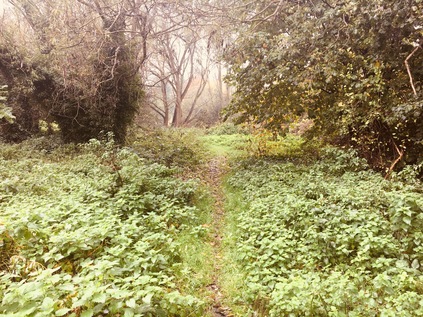
The river wound around the edge of a golf course, providing a boundary between the primped greens and fairways and the much more democratic municipality of Pitshanger Park. I followed its course as closely as I could here, remembering how tricky it had been to walk alongside the river further upstream. The scrubby fields between the road and the park were deserted except for a lone dog walker who patrolled the perimeter, eyeing me with a little suspicion as I trudged carefully around some of the wetter spots on the path. The river turned west, and I needed to retreat to the roads to find it again, doing so via an inelegant clamber over a stile and into the attractive and quiet streets of Brentham Garden Suburb. This rather sleepy and at first unremarkable estate is in fact an early example of a cooperative housing development built to incorporate Ebeneezer Howard's principles as outlined in 'To-morrow: A Peaceful Path to Real Reform'. Published in 1898, this work kickstarted the Garden City movement which suggested the possibility of enjoying the conveniences of city life in almost rural settings. With construction beginning in 1901, Brentham pre-dates its better known and now rather exclusive cousin at Hampstead by some years but being a little further out of the city, isn't perhaps well positioned to become the haunt of the well-to-do and famous. Walking west, towards an entrance to Pitshanger Park, I watched the estate waking up - supermarket delivery vans puttered between streets, families wandered outdoors, wrapped in winter clothes. The rain had almost stopped as I turned into the park entrance which was guarded by a gang of gossiping dog walkers, their bored hounds grunting and sniffing at the floor in anticipation of their excursion recommencing. I set off across the park to its northern boundary where the river was hidden behind a line of trees. There were few others in this part of the park away from the sports club and café, and while still a little damp my walk was quiet and pleasant. At the edge of the park I turned north along a narrow hedge-lined alleyway cutting through the golf course. The river, after being joined by what appeared to be the stub of a forgotten tributary or former diversion, also turned north, and through the hedge I could see it winding between greens and fairways, providing a genuine challenge to errant golfers.
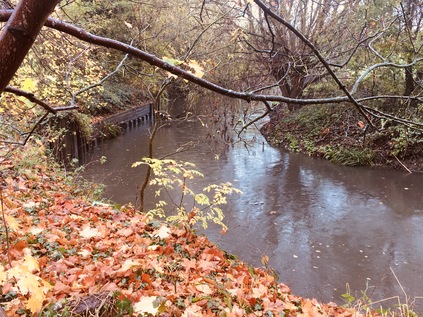
The path divided near a wooden bridge over the Brent, marking the point where I'd expected to enter the park had my excursion through the fields not proved viable. I turned west again, rejoining the river as it took a broad loop to the south and then north along Argyle Road. A detour here took me close to the riverbank as far as Perivale Lane where I feared I was trespassing on the grounds of St. Benedict's School. I tramped back to Argyle Lane, retracing my steps rather than following an arc around the playing fields of a leisure centre which, while closer to the river were clearly muddy and very wet and offered no clue about how I'd escape at the other end. I began to fear that perhaps the Brent was to be as elusive today as it had been on the first part of my walk in from Finchley. I headed west along Ruislip Road East, a long straight route running directly from Ealing to Greenford which the borough had recently improved to favour walkers and cyclists. Frequent banners hung from the fence behind which the river ran, informing me how this five-mile long route was safe, well provided with frequent crossings and speed controls and could enhance my health and wellbeing. Indeed there did seem to be a fair number of people wandering back and forth as I passed under the railway line from Greenford with the Brent churning darkly under the adjacent arch of the bridge. The road began to rise towards a junction with Greenford Broadway, crossing the river by way of an ornate bridge. Beside the bridge a gap in the fence provided a surprisingly anonymous entrance to the continuation of the Capital Ring walking route. I'm still asked fairly often if I'm 'doing' this walk - and equally often I'm told how unattractive and borderline dangerous my questioners found the walk. At this point I'm forced to grit my teeth and suggest that I'm not walking the route but inevitably I'm encountering parts of it on my travels. I'd love to add that circling a vast, complex city like London is bound to take a walker through a variety of landscapes which make up the edgelands, but I suspect they're already busily ticking off their next sanctioned and sanitised walk somewhere. After a brief pause to buy lunch I returned to the inconsequential gap in the fence and plunged into the cool, quiet tunnel between the trees which lined the river here. Near the road there was the usual evidence of temporary occupation: blue carrier bags, Polish lager cans, the marks of extinguished fires and discarded clothing - but soon these petered out too, and it was just me and the river. The Brent was wide and fast-flowing here, swirling with rainwater from the numerous streams and gullies which joined it on its suburban journey. This wedge of parkland, hemmed in by a recycling centre and a large development of inter-war housing was almost entirely deserted. The sky churned overhead, but promised brighter conditions might be coming later, and I happily trudged south, the river tumbling and twisting beside me. The way was marked by infrequent wayfinding posts, and one of these sent me down a flight of wooden steps cut into the steep valley side and onto a rarely walked diversion on the bank of the river. Unsure if this path would safely return me to my route without a muddy scramble, I was a little uneasy about heading onwards - but the lure of the water was strong and I'm glad I continued. This was the closest I'd managed to get to the Brent so far, and it felt good to be walking beside it more directly for a short spell as it cascaded over a weir and swirled around hanging boughs of trees which leaned down into its surface. Returning safely to the path further ahead, I crossed a bridge and found myself on a comparatively well-made stony path passing directly through another golf course, marked by signs warning me that by passing them I accepted the risk of encountering low-flying balls. There were few golfers braving the unpredictable November weather today, so I gladly took the chance and continued. The river was to the east now, denoted by a snaking line of trees beyond the flags and bunkers, and I once again wondered how much more of it I'd manage to see? Above the trees, the steeple of St. Mary's Church in Hanwell was a black silhouette on a turbulent and dramatic sky which seemed to shift to dominate the view from every direction as the path turned with the river. There has been a place of worship here for well over a thousand years, and it struck me that the development of parks and golf courses around it meant that it still provided a landmark from some distance away with little encroachment by other tall buildings. The path rejoined the Brent, crossing it by way of a solid but scruffy metal bridge, and then divided again - the more formal sandy track leading up to the church while a series of wooden flets sunk into the muddy bank took the path into a broad meadow and towards the curve of the river again. I chose the muddier path and stayed with the Brent.
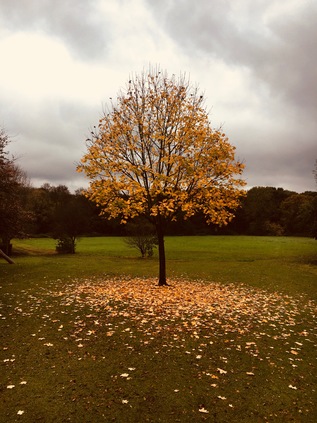
At the top of the steps I found an expansive park, surrounding the fences of Hanwell Zoo and allowing me to take a wet but relatively mud-free excursion along the riverbank as it wandered east around the edge of the Millennium Maze and into Churchfields Recreation Ground. The thunder of trains could be heard over the chatter of children and braying of goats, apparently the only animals braving the wet weekend morning in a compound at the back of the zoo. It occurred to me that I'd soon be passing under the Great Western Railway which had brought me into Paddington a few hours ago, the twists and recursions of today's journey echoing the contortions of the Brent. Now though, the river slunk quietly in a low gully at the foot of the park, screened by high trees and hedges which hid the graceful arches of Wharncliffe Viaduct from view until at the foot of the sloping parkland one of the great arches leapt into view, gracefully crossing the path and the river. This awe-inspiring structure was one of the earliest projects attributed to Isambard Kingdom Brunel, and also one of the first completed along the route west from Paddington to Bristol with trains running above from 1838. The viaduct also has the honour of being one of the first buildings 'listed' for preservation in 1949, and such forms a key part of the bid to have the whole original GWR route named a World Heritage Site. While it remains unclear if Queen Victoria really did insist the Royal Train pause on the viaduct to let her enjoy the view along the Brent Valley, there are now others who linger here - namely a vast colony of bats which live within the hollow archways. The river turns south again here, initially in a brick culvert which neatly brings it alongside the path and under one of the easternmost arches of the viaduct. Looking along the structure, its grace and scale are overwhelming, and perhaps not fully appreciated until viewed from the hay meadow to the south of the line where Lord Wharncliffe's family arms are visible on the central span - recognition of his support for the parliamentary bill authorising the Great Western Railway. I paused here, trying to get a picture which would truly show the sweep of the arches over the valley, an amused dog walker letting his charge scamper in the long grass while he watched me struggling to frame the shot against a dull grey sky. Behind me as I faced the wonder of Victorian engineering, another impressive bulk of a different era loomed: the huge Ealing Hospital - a solid grey block raised above a wide pediment, with ramps leaping and curving from the ground to deliver ambulances direct to the entrances. I'd passed this way countless times, spotting the rather grim building from trains speeding west from Paddington, but up close the building felt impressive, dour and overbearing. Before reaching the Hospital, the river needed to pass under the Uxbridge Road via a low stone bridge. There was a choice of routes here - the path ascended to cross the busy road at grade, or I could stay beside the river and pass under an arch in the bridge built to accommodate the footpath. This passage dipped low, close to the river's edge and appeared worryingly waterlogged. I weighed up the alternative route up to the road, but decided that I was brave enough to attempt the slither down the stone slope and under the bridge. In the edge of the river beside me, a forlorn and slowly moulding office chair was marooned in a shallow pool of greenish water. The roof was close to my head, stippled with drips of calcification and dangling here and there with more ambitious stalactites, but the passage was uneventful save for paddling through an inch or so of water - either rainfall or overspill from the Brent which felt perilously close. The path climbed again, rising to pass close to the eastern perimeter of the Hospital, revealing the inner workings and complexities of the building, rather spoiling the illusion of the futuristic swooping concrete ramps and the rather inhuman face of the tall concrete blocks. Built in 1979, the site fills the nook between the River Brent and the mainline of the Grand Junction - latterly the Grand Union - Canal. To the west of the current hospital the former Middlesex County Asylum, opened in 1831 remains in use as a modern psychiatric unit, still sequestered behind a solid red-brick wall. Known for some time as St. Bernard's Hospital, the facility pioneered early forms of occupational therapy under Dr William Ellis its first superintendent, and was later instrumental in the removal of restraints in favour of less invasive means of protecting patients, including the padded room. The relative humanity of the regime at Hanwell under Ellis is evident in his principled resignation upon learning that the Commissioners and Justices wished to cram more patients than he felt could be properly be cared for.
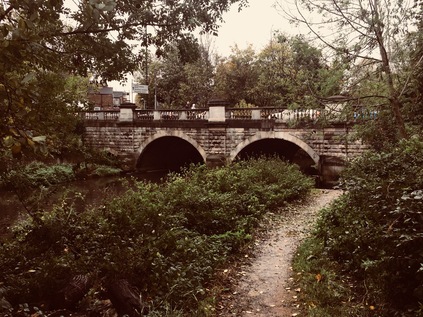
This corner of Hanwell also holds a significant place in the nation's industrial history. Beyond the hospital the path divided, with a spur leading up to the towpath of the canal at the bottom of the Hanwell Flight - a series of six locks with associated balancing ponds built in 1794 to bring the Grand Junction to the level of the Brent, with which it merges nearby. As I emerged beside the bottom of the flight, two young couples were beginning the ascent of the flight, enjoying the sunshine which had finally escaped weakly from the cover of low cloud and not yet tired from, or perhaps fully cognisant of, the effort required in operating the six locks to raise their boat through fifty-three feet. I was tempted to follow the canal but I stuck with the river path as long as I could, taking the path which shadowed its last sluggish twists between the cottages on Green Lane and the canal, before finally reaching the junction under a brick bridge. From here I would be walking the southern part of a route which was navigable to Birmingham and beyond, and which had revolutionised transport in the 18th century. The River Brent, for a time at least, was subsumed into the wide, businesslike line of the canal - but it wasn't entirely absent. The river's meanders and twists as it approached the Thames largely dictated the course of the canal. Where the meanders were too tight and wide the river branched from the canal into foliage-choked and litter strewn loops which tumbled busily over weirs while the canal took a more sedate route through the wide green spaces of Osterley Park. The grand house here has its origins in an Elizabethan Manor which, at a respectable distance from London attracted the Child's, a well-connected banking family who in 1761 engaged Robert Adam to rebuild the house which was by then in considerable disrepair. Osterley House was once set in open countryside, and while its immediate grounds remain a park in National Trust management, a surprisingly large area of apparently unmanaged open land which would once have been part of its substantial grounds shadows the Brent here. To the east of the river this has become a managed wildlife area, part of the chain of spaces which make up Brent River Park. To the west the former Great Western Railway branch to Brentford runs broadly in parallel, passing the curiously named Trumpers' Crossing nearby. On the towpath, a large sign notes the location of the prize-winning length of pile in the 1959 Kerr Cup Pile Driving Competition. This contest, apparently organised by British Waterways, appears lost to history - even Google largely drawing a blank except for references to the sign itself. Both canal and railway pass under a more modern transport innovation here too, with the M4 sweeping above on a curving route into West London via a practical and unadorned concrete and iron overbridge. The traffic shuddered and screeched above, the notoriously bottlenecked road seemingly flowing freely for a welcome change.
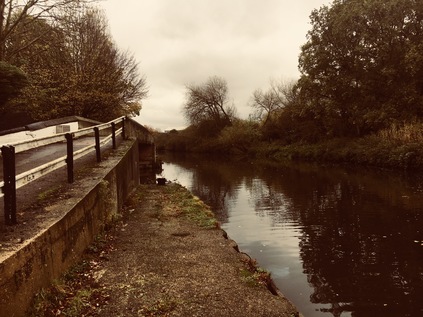
For a while, the motorway, railway and canal ran in parallel along the broad lower Brent valley. The river meandered to the east here, passing around large wooded islands under the road, traffic above seeing a carpet of treetops below and largely unaware of the presence of the waterways. The towpath climbed over the river by way of an elegant iron bridge spanning solid, brick piers. Beyond the fence the silent machinery of a waste transfer station waited restlessly for the next load of detritus from the suburbs. This was once Brentford Town station on the somewhat unloved Brentford Dock branch, Brunel's final railway project before his death. The aim was to secure a GWR connection to the tidal Thames at Brentford - but the line struggled from the start with objections to its construction raised by the Grand Junction Canal Company and the Duke of Northumberland, owner of nearby Syon House. When eventually opened to goods in 1859, and then to passengers in 1860, the initially single track, broad gauge line failed to deliver on its promise in attracting commuters. The anticipated passenger flows to the Dock for ferries to Kew Gardens didn't ever begin operation, but freight traffic grew steadily with cargoes transferred to barges at the busy docks beside the Thames. By the time services were suspended as an economy measure during the First World War the branch was operating as a more conventional double track spur from Southall - but passenger traffic was never strong, in part because the connection to the mainline faced west making through-trains from Paddington unworkable. The London & South Western Railway had arrived in Brentford in 1849 with swift services direct to Waterloo - and the GWR simply couldn't compete. Despite restoration after hostilities ceased, the service was reduced to a peak time shuttle in 1929 and ceased entirely in 1942. Perhaps surprisingly, freight traffic continued to the goods depot at the Town Station site until 1970, with private sidings serving Firestone and other factories along the 'Golden Mile' of the Great West Road - the great mid-century sprawl of industry out to the west of London. Now the line stops short of its former crossing of the A4 while the collected waste of Hounslow, Ealing and Richmond is sifted and containerised at the railhead. Soon after passing under the road near the vast mirror of the Glaxo Smithkline global HQ, the river is bridged by the L&SWR's 'Hounslow Loop' - and with electric trains passing frequently above it's perhaps easy to see why the Great Western's branch never quite made its mark as a passenger railway. I emerged from beneath the Great West Road to find the hulking remains of an overhanging warehouse leering out into the waterway. It appeared that boats awaiting repair were now stored here, somewhat sheltered by the structure which seemed to be in the midst of a long process of overhaul. The path edged around the skeletal building, feeling oddly unofficial - this area was in the throes of redevelopment with the walkway temporarily transferred onto an unnerving floating pontoon in the canal. I trudged carefully along the queasily oscillating plastic walkway, noting the modern apartments which had encroached on the broad canal as it approached Brentford Gauging Lock. Walking here felt like trespass, and I wasn't sorry to emerge on Brentford High Street which felt down-to-earth in comparison to the eerily quiet developments along the canal.
Brentford High Street was surprisingly quiet too, with the Great West Road now taking the strain of much of the through traffic. At this, western end of town things were starting to feel the effort of gentrification - pubs were smartening up and a few specialist stores opening opposite a modern hotel building on the edge of the Canal basin. The towpath continued, descending via a slick, steep flight of stairs onto a narrow ledge which turned east along the Brent's final meander towards the Thames. This part of the walk had looked straightforward from the maps - a last trudge along the path to the confluence - but it was a surprisingly complicated endeavour. Firstly, the path was confusingly discontinuous and was often thrown aside from the water by private stretches of mooring. At one point following the path necessitated clambering up onto a concrete ledge to cross the river frontage of a timber merchant's warehouse which would formerly have received deliveries by barge. There were few people around and sparse signage to indicate I wasn't way off track - making the narrow and unclear right-of-way feel strangely menacing. The afternoon was becoming warm too, with the morning's mist and rain now a memory as the sun beat down on the water, reflecting dizzily back at me. I crossed the river again near a muddy inlet which reminded me that the River had now taken precedence again, and that this was Brentford Creek rather than the managed route of the canal. Immediately after crossing the bridge the route descended a steep staircase down to the grassy riverbank, as the more solid walkway through the Brentford Dock Estate remained private. Design of this development of homes by GLC architect Sir Roger Walters began on the closure of the docks in 1964, and building was finally complete by 1978 - the year of his retirement. Originally proposed for social letting, only around one fifth of the units were rented with leases for the rest sold by the GLC, resulting in the privately managed estate of today. In 1980 the associated Marina development was opened by the flamboyant GLC leader Sir Horace Cutler arriving by boat from County Hall. Cutler was by all accounts very keen on such showmanship, and although his administration is regarded as largely unsuccessful, he raised ideas which later found more general acceptance - not least the extension of the Jubilee Line into Docklands to spark regeneration, the promotion of the London Marathon and an audacious scheme to bid for the 1988 Olympic Games - which failed to find Government support. Cutler also correctly predicted that if elected, the Labour leader Andrew McIntosh would be ousted by the left of the party and that Ken Livingstone would become GLC leader. However, fighting the election on this negative basis seems to have assured Labour of the very victory which Cutler feared. Six years after Cutler's triumphant arrival stunt at Brentford Marina, the GLC which he had himself described as "too big, remote and shadowy" was finally abolished by the Thatcher government, nominally for those same reasons.
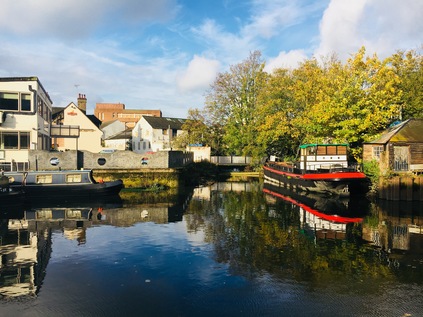
I crossed the Brent for the final time at Thames Lock - the tidal gates which controlled entry to the docks until their closure, and which still allow experienced boaters to access the Thames at designated times. The area around the lock was a pleasantly haphazard zone of chandler's yards and crumbling warehouses which transported me with a jolt to the unreconstructed reaches of the Lower Lea Valley more than a decade ago. Boats of all kinds were visible, some floating queasily askance, others hoisted from the water and in various states of repair or decay, but no-one seemed in a hurry to do much this sunny, Saturday afternoon. Here too, regeneration was slowly encroaching - and the people who I met crossing the bridge over the last loop of the river were upwardly mobile, young and optimistic looking types. Dock Road led down towards Brentford High Street which was a confusing and somewhat downbeat mix of buildings awaiting demolition, new developments and tired looking blocks from the late 20th century. A little further east I found the signposts marking the route to the Thames Path. Here, like some of the places I'd encountered the path in the east of the city, there were discontinuities and complex diversions where the riverfront rights of way hadn't yet been resolved. A short way ahead I found an alleyway which returned me to the final few metres of the River Brent at Point Wharf Lane beside some tidy and well-used residential moorings and some shiny newly built apartments stacked atop a trio of Turkish, Indian and Italian restaurants. The last mile of the Brent had been quiet and residential, and felt curiously private in nature. The river belonged to those who lived beside it and I felt like an intruder walking the path beside their homes. As the path turned east, I realised that I'd unexpectedly reached the point of confluence - and I tried to snap a picture inconspicuously over the heads a family working on their boat. I also calculated that the walk from Perivale to this spot had in fact been around ten miles in length - there was certainly no way I'd have finished this walk on my last outing, and perhaps I'd been too tough on myself for not pressing on to Brentford. after all? My estimate, minus the winding and curving of the river, had been dramatically off beam. Now I needed to head briefly back inland near the giant stainless steel swoop of Simon Packard's 'Liquidity' sculpture - a commission which had almost broken the spirit of the artist - standing resolutely on the quayside at Ferry Lane despite local homeowner's protests at its size.
The Thames Path meandered confusingly again, through a forbidding iron gateway and up a strange flight of outdoor stairs at the rear of Waterman's Park - an apparently abandoned 1970s office complex which felt like a set from a TV show. I expected to be chased along the raised brick gangway by Denis Waterman at any moment. Eventually though, I found my way through to the park proper - a sliver of green which runs along the Thames, the site of the former Brentford Gasworks which closed in 1963. A busy arts centre now occupies part of the cleansed and remediated land, and the river moorings are contested territory - longstanding residents forced out to accommodate luxury boats. Beside me the brown waters of London's river parted to sluggishly churn around Lot's Ait and Brentford Ait - a pair of wooded islets in the river. Up ahead, the tall tower of the former Grand Junction Waterworks Company loomed at Kew Bridge, marking the point where my South Circular walk had returned me to the north bank of the river. This dogged but doomed company had tried in vain to extract clean water from the Brent and the Colne, but resorted in the end to syphoning off the murk of the Thames and using the lofty standpipe tower as a means of filtering out the worst of the filth and detritus. Somehow, even when I least expected it, my walks formed connections and strengthened my sense of the city. My earlier walk along the northern reaches of the river had almost convinced me that these western tributaries would be frustrating to follow and wouldn't form substantial walks, but today had persuaded me otherwise. I waited for one of the trains which had passed over my head earlier to arrive at Kew Bridge and take me swiftly back to Waterloo while I pondered my eastern prejudices. It's true that having been engaged in other parts of the city had made me pine for points east, but if these western walks continued to produce these new and surprising insights into the fringes of the city, then I'd be back to walk more of them. At times during the previous month, the River Brent had felt like a millstone - unfinished work, an incomplete walk sitting on the ledger - but it had in fact been deceptive - a river much longer, swifter and deeper than I'd imagined, and a route surprisingly capable of capturing my imagination. I wasn't the first to be persuaded it seems, and it was interesting to ponder quite what our former Poet Laureate would have made of modern Brentford?
Gentle Brent, I used to know you
Wandering Wembley-wards at will,
Now what change your waters show you
In the meadowlands you fill!Sir John Betjeman - Middlesex - 1954
You can find a gallery of pictures from the walk here.
London has an enviable reputation as a resilient city. It has been burned and flooded, bombed and relentlessly attacked from within - yet it stands. Its people, in particular, are regarded as stoic and resolute - defiant against all the odds. Even during the recent terrorist attack at London Bridge, they were to be found hurling chairs and pint glasses at the assailants, rather than turning tail and running. Some of this is, of course, hyperbole - and some wishful whimsy - but there's no denying the endurance the city has shown over a couple of thousand years. But London has two key weaknesses which have resurfaced over the millennia to threaten the city's hard-bitten citizens - the very air and water which sustain them. Both have rebelled against being used to support the sheer concentration of humanity that the city presents and both have proved real threats to the health of generations of Londoners. During a weekend where Sadiq Khan stepped up his efforts in a campaign to detoxify the air in central London using some slightly confused but well-intended statistics to prove his points, I found myself approaching a solution from an earlier age. A time when the importance of clean drinking water wasn't an established scientific fact, but the evidence of Londoners' senses told them things weren't good and that something needed to be done to sustain the supply without the torrent of filth that had begun to choke the natural rivers which tumbled towards the Thames.
It was good to set out early, stumbling from our Shoreditch hotel towards Liverpool Street for early coffee - wondering quite how the NatWest International Markets employee had the early-morning energy to grope and manhandle a female colleague as they waited for a huge order of drinks for their team back at the office. The barista made my drink swiftly and with a raised eyebrow and shake of the head, passed it through the front of the stall rather than the serving window, which was fully occupied by the amorous pair. Downstairs the station was eerily quiet, the first few trains of a Sunday morning beginning to shudder into life. I was familiar with the run out to Theobalds Grove from an earlier walk, but the chance to set out early and watch misty dawn rising over the east of the city was a rare opportunity. I saw the territory I'd walked, some of it drab and downbeat in its day-to-day life, glowing and burnished in the dawn. I had a long walk ahead but mercifully, due to a lack of real planning, I had only the vaguest idea of the total distance I'd cover if all went as I hoped. The scheme was simple enough - to strike out west from Theobalds Grove and to find the New River. Then to follow this artificial waterway, venerable despite its name, to its terminus on the fringe of the City. The New River has wound through other walks in the north of London - tantalisingly paralleling my travels along Green Lanes, crisscrossing my excursions from west to east through Woodberry Down, and complicating my search for lost rivers and roads. I'd also visited its usually forbidden terminus around a decade ago during an Open House weekend, when an eccentric Islington local decided to give impromptu historical lectures and appeared to actively loathe the New River for some unknown slight. Today though, I'd stick with the River as far as I could, navigating reasonably close to its path where its course disappears or dives inaccessibly between back gardens. As my few fellow passengers trudged off towards their homes or jobs in Waltham Cross, I turned west towards the Hertfordshire countryside. This was an ambitious undertaking, which had been a long time coming...
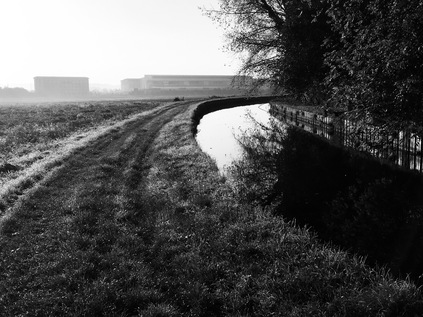
After a brief suburban trudge alongside the almost-hidden Theobalds Brook which was screened from the adjacent and properties by a low brick wall and a line of trees, I found myself taking an unexpected turning beside Cheshunt FC's home ground. Here, the Paul Cully Bridge climbed over the A10 as the road beneath took a dead-straight course towards the M25 and Central London. The bridge was opened in 2010 and named for a late councillor who had long campaigned for an improved link between the communities in this part of the Borough of Broxbourne. The opportunity finally came from a fortuitous mix of Sustrans funding and the decision to host Olympic events at the nearby Lee Valley White Water facility within the borough. A strange video exists of the gleaming white bridge, lined with schoolchildren who are slowly passing a flag bearing the ill-starred London 2012 logo over the bridge, inch by endless inch. Councillor Cully's case for the bridge proved well-founded, as it appeared to provide a useful link to a local school, and between the communities that cluster along the railway line and the valley floor here. Despite its perhaps ill-advised white paintwork looking mossy and traffic-stained, it was clearly well used at times - though quiet this early Sunday morning. Between the distant shapes of factories and housing looming in the mist a vast flat area of former green belt land, part of the estate of King James I's Theobalds House, had recently been parcelled up as 'Park Plaza' - though only sporadic development appeared to have taken place west of the Great Cambridge Road so far. The great house which King James acquired in exchange for Hatfield Palace in 1607, and where he died in 1625 was swiftly and surely destroyed during the interregnum, with the estate passing between the crown and various nobles after the restoration. By 1888, the estate was in the hands of the Meux family whose fortune had been made in brewing. Lady Meux had been a City barmaid herself, and on hearing of the impending destruction of Temple Bar, the now inconvenient gateway which bottlenecked traffic passing along Ludgate Hill, paid the sizeable sum of £10,000 to have the structure dismantled and re-sited on the Theobalds Estate. It remained, slowly decaying after Lady Meux's passing, until 2003 when the campaign to return it to the City finally succeeded. Having made a more expensive and equally painstaking return journey, it now sits in a somewhat anodyne new development at Paternoster Square - but is at least preserved in good condition. As the bridge descended into the fields beyond the road, pockets of persistent mist floated in the dew damp grass. The sun picked out the droplets of water on a low gate leading down to the New River path which curved gently in from the north. Here my walk was to begin in earnest, with just the distant murmur of the M25 for company.
The New River path is largely a permissive right-of-way which runs, with some breaks and diversions where necessary, between the point where the waters part from the Lea at New Gauge in Amwell roughly to the river's current and former endpoints in Central London. For much of its route, it is a simple, flat grassy space beside the river provided under the sufferance of Thames Water, with a few more formal surfaced sections where it intersects with other's land and developments. For that reason, it felt sensible to tackle the path now rather than during the comparatively muddy winter months when parts may well become impassable. I could perhaps have travelled further north to start walking closer to the source, but my intention was to reach the city in a single day of walking on the basis that I had more time than usual and didn't need to maintain a furious pace. That said, it was hard not to be lured out into the flat, open Hertfordshire countryside which flanked the settlements chained along the valley. I consoled myself with several additions to the list of walks I might take, and set off down to the river, immediately passing under the busy B198 via a modern, graffiti emblazoned underpass. The river curved gently into view around an unharvested field, it's surface a still mirror of the morning sky. The channel ran between wooden boards, broadening slightly to encompass an island where Lady Meux is said to have kept a menagerie, though the only animal life here now was a squadron of ducks that patrolled the pool around the island. To the south-east, the low anonymous hulk of News International's print works rose from the mist ominously. The clamour of the road was growing, and I knew I'd soon be crossing into London. These last few yards of countryside felt precious and worth savouring as the path turned south and crossed a byway which led towards Tottenham Hotspur's training Bullsmoor ground. Soon though, the river was swallowed by the twin concrete tunnels of the aqueduct which carried it over the six lanes of the M25 careering towards the sliproads of Junction 25 and the tunnel under Bell Common. The footpath ran across the roof of the channel, providing a broad dry crossing point that emerged having crossed to the western bank of the river. This habit of changing banks at crossing points would persist for much of the walk, and soon became part of the routine of walking this surprising and sometimes confoundingly elusive waterway.
Given how long the sound of the motorway had prefigured my crossing from the north, it lapsed surprisingly quickly into silence once I was within its circle. The river soon reverted to its sedate, grassy state for the journey south. A kink in the otherwise remarkably direct course took the river around the grounds of Capel Manor, which can be traced back to 1547 when 'Capels' inscribed on a contemporary map denoted the seat of Sir George Capel and his line - the Earls of Essex. Now the simple but elegant 19th-century replacement building is occupied by Capel Manor College - specialising in horticultural and agricultural pursuits. The college is set in extensive gardens, which in turn hide the ruins of the 15th-century manor house. It's clear that this spot on the fringes of London, perhaps a day's leisurely ride out, was the chosen home for the influential and well-connected until relatively recent times, and still harboured a number of expansive if more modern well-heeled dwellings even now. As I meandered with the river I spotted a curious thing - a crablike claw, stripped of flesh up to the solid, razor-like hooks but still pink and fresh, was discarded on the grass. There were in fact several here, all seemingly recently deposited. I pondered the distance from the De Vere Hotel, now occupying Theobalds House, wondering if a fox had raided their waste bins? However, these weren't the last similarly intact claws I'd see on my travels - and some research indicated that the River Lea and its associated system had been invaded some years ago by aggressive American Signal Crayfish. Their aggression, along with a plague transmitted by these non-native incomers had all but exterminated the native species - but perhaps now something was preying very effectively in turn on these new denizens of the river? There were certainly stories of bucketloads being hauled out by restaurateurs, but this looked a little smaller-scale - maybe an ambitious fox or a bird?
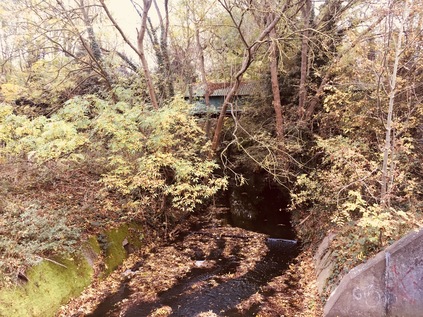
I passed through a kissing gate of a type which was to become very familiar over the course of the walk, which took me across Turkey Street leading west from the station of the same name which I'd passed through earlier on my journey out to Hertfordshire. There is nothing to connect the street or the brook from which it takes its name with the seasonal fowl, and it appears far more likely to be a corruption of a local family name. The brook presented a genuine challenge for Myddleton when plotting the course of the New River. The channel uses gravity to convey water towards the city, carefully hugging the contours of the landscape to gradually descend from the northern heights. The valleys of the various tributaries of the Lea which carved into the higher land thus proved problematic, and the only sensible solution at the time of building was to take the otherwise straight river in broad loops around the heads of these streams. Thus, as the footpath descended into the surprisingly steep gully in which the Turkey Brook runs, the original course of the New River swung west into open land. A path followed it, and the temptation to take it was strong - but the wish to see my route through, along with the desire to get a look at the placid and shallow Turkey Brook at the foot of its valley kept me on track. The New River was straightened by the building of the Docwra Aqueduct in 1859 which takes it above the brook, and then directly south via a long straight section that emerges from culvert where the path ascends from the valley. The old course of the river is patchily extant, a ghost waterway in places and a weed-choked reedbed in others, but can be walked - providing the potential for another future expedition perhaps?
It was here, contemplating the huge detour which the river had taken to follow the 100ft contour line around the valley, that I began to really appreciate the undertaking that the New River represented. Edmund Colthurst had begun the work on receipt of a Royal Charter in 1604 but soon ran into financial difficulties. Myddleton took on the task of completing the works in 1609, with Sir John Backhouse providing considerable support, not least in the form of expensive land in Islington for a reservoir at the river's head. Even then, the project threatened to collapse as landowners refused to grant leave to pass over their fields, fearing inundation of crops and drowning of their stock should the channel burst its wooden retainers. Even then, the value of these lands on the edge of the city was a vexed question, and the great tradition of British reluctance to get behind new developments is not a new one it seems. Only the intervention of King James I as a guarantor and shareholder saved the project, and finally by 1613 the river was bringing fresh water from the springs of Amwell to the fringe of the City at Sadler's Wells. I realised with some reluctance as I approached the crossing of Carterhatch Lane that the section which I was walking now, passing through Forty Hill with its 17th-century hall and estate, was probably the last truly rural stretch of the river which I'd see today. Beyond here the river was hemmed in by development on both sides, the path discontinuous and sometimes elusive. It was remarkable though that the New River had survived above ground quite as far into London as it has while other more venerable rivers were fouled and spoiled, and finally cast into hidden culverts. The influence of the King with his edict that casting filth or carrion into the river or planting trees close to its banks would incur his 'displeasure' seems to have been oddly effective. The New River Company, founded in 1619 to manage the river and its associated supplies of water to the City survived too, managing the waters until the formation of the Metropolitan Water Board in 1904, proving the perhaps surprising point that publicly owned utilities are a surprisingly modern phenomenon.
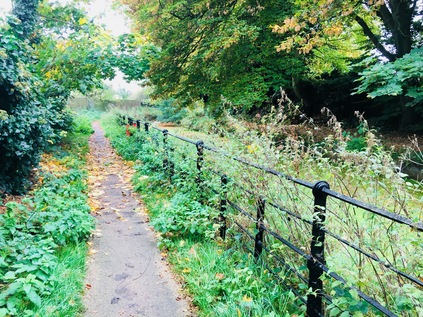
Forced to step away from the river here for a spell, I crossed to the western side via a pedestrian bridge and ventured into the hinterlands of Enfield. The river once made another loop here, passing along Southbury Road and into the town centre in a channel which has been preserved as a civic amenity. The businesslike waters now flow underground by a more direct course, but the vivid green of the algae bloom in the channel makes for an interesting walk into the town, which was just beginning to awaken. Sunday morning in Enfield was slow to start - the sizeable supermarket on the edge of town not open yet, and the smaller businesses only now beginning to spring into life. Here in Enfield, even the disconnected loop of the river disappears under the buildings on the north side of the main street, and I decided to pause for coffee at a spot which might well have been over the course of the old channel. I didn't spy the river again until I reached the bridge at the edge of Town Park, where I recalled seeing the river for perhaps the first time many years ago. This green space is the last remnant of the great Enfield Old Park - a hunting ground for royalty and a reserve for game - and the loop of the river is overhung by weeds and plants here in a way which would be unthinkable along the well-tended length of the working channel. The once sprawling park has endured numerous indignities over the years: being enclosed by act of parliament in 1777 and then suffering the fate of much of the modern green belt in the borough by being parcelled between several golf courses in the late 19th century. With both the Great Eastern and Great Northern Railways well established by the turn of the 20th century, the growing desire to move out of the city and to commute from the suburbs made development of the land irresistible and much of the remaining park disappeared under various well-to-do estates south of Enfield. I crossed over the river loop, leaving it to turn back east towards its original course while I started the steady climb up Carrs Lane, a sudden delve into a rural and tree-shadowed thoroughfare that bisects Bush Hill Park Golf Club. It was strange to be walking through a tunnel of greenery with the swishing and thwacking of club and ball just beyond the hedge, cries of delight or dismay echoing through the trees near gates sternly marked as PRIVATE which allowed members to pass from the green to the next tee by crossing the lane. Named for a prominent Victorian landowner, William Carr, the lane was once part of the drive into the Old Park and up to Windmill Hill on the western edges of Enfield. Now it holds its nerve as the last sliver of public land in a privatised and primped landscape of flags and bunkers.
After a few minutes of pleasant country walking, Carrs Lane deposited me on a busy corner near to familiar ground at the top of Bush Hill. Several of my walks had brought me close to this point where the New River flowed back into the open and along a raised bank of earth which was erected in 1786 to replace a timber and lead aqueduct known as the Bush Hill Frame. The structure carried the river over the steep and narrow valley of Salmons Brook, the little stream still trickling below the raised channel. I was curious to revisit the Clarendon Arch which I'd stumbled across on a previous visit, but sadly the narrow staircase down to the viewing platform was fenced off and the whole site was looking a little decrepit and unloved. Under the road here the stone arch has allowed the passage of the river over the brook since 1682, and it was truly a saddening sight to see this small but significant piece of history hidden from view. I returned to the road and pressed on south to Mason's Corner where I met Green Lanes, and where I could once again access the river bank. Now, for quite a distance, the course of the ancient drover's road and the river were inseparable - both taking advantage of the flat land and slightly descending contours to advance on the north of the City. The road and the river swayed closer and further apart as they progressed south, with the river regularly passing under shallow bridges carrying suburban side-streets, heralded by the now-familiar green kissing gates, often necessitating a switch to the opposite bank. For the first time here I began to encounter others on the path - since I left Theobalds Lane I'd seen only a handful of dog-walkers on the path, all of whom had been keen to bid me 'good morning' but now mute joggers and self-absorbed walkers were more often sharing my route. Thankfully, given the grassy and often uneven surface, cyclists were less commonly spotted here unlike on the towpaths of Central London where they cannoned uncontrollably along the narrow ledges beside the water. Despite the river's relatively broad and uncluttered banks through Winchmore Hill, the path became surprisingly fractured here, often deviating into roads and alleys. I found myself trudging along the tantalisingly named River Avenue which mocked me by following every minor kink in the route of the river which ran beyond its back gardens. Under a suddenly gloomy and oppressive sky, I finally regained the path properly near Palmers Green Mosque via an uninviting alleyway and a clamber up steps set into the bank beside another gate sitting in the midst of the grassy bank, strangely isolated from any fence. Soon after setting off, I was confronted by a persistent and immovable gang of geese blocking my way. I tucked my hands well into my pockets, my chin into my chest, and pressed on, swerving around the biggest of the birds as he strutted along the path looking for food, apparently unconcerned with the foolish human murmuring for him to 'stay calm'.
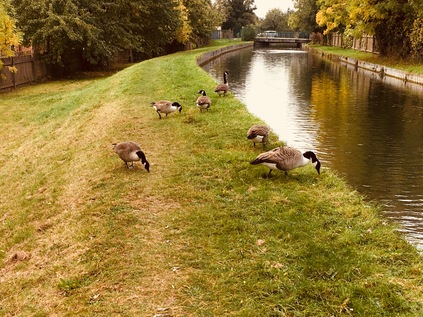
The river turned west and I was again forced to detour by road, briefly walking north along Green Lanes to find a footpath back to the bank via steep steps down beside the fine municipal architecture of Southgate Library. This curve of the river felt familiar, with the railway high on an embankment to the west, screened by mature trees which parted to reveal the brick culvert of a bridge. Here Pymmes Brook passed under the river on route to Edmonton. I had missed this secluded part of its route when I walked this way, being pushed out to the North Circular to cross the valley and regain the brook. The road was close, a tell-tale sign of passing traffic rising above the swish of the trees and the distinctive fumes beginning to sting my nostrils. I recalled my brief visit during my circumnavigational walk and particularly remembered the narrow, litter-strewn and nettle-lined passageway which led from the road to the river near one of the automated gantries which sieved and scraped rubbish from the water. Today it was in action, its metal claws lazily grabbing dripping boluses of mud, twig and leaf from the New River and piling them on the concrete hardstanding beside the road. The path onwards was complicated by a road crossing, but I soon found the continuation of the route in a small park near Russell Road. I rested a while here and ate lunch while contemplating my progress and the seemingly impossible distance still to travel. For the duration of my stay in the rather windswept trap for road-litter, fumes and dust, an older man had sat nearly still, his only movement a finger scrolling at the screen of a 'phone. He wore a thick, padded anorak, zipped to the neck despite the warm autumn afternoon and the heat radiated from the road. When I moved on he stayed, still scrolling, still looking intently at the small screen. The well-tended banks of the New River were once patrolled by 'walksmen' and their assistants, travelling together on adjacent banks, clearing the river of obstruction and preventing access by bathers or others who might make mischief. I wondered if any of them had rested too in this spot, before turning back towards the City - and whether this mysterious character was descended from them?
Heading south along the river, the sound of the road soon slipped into the distance. Now I was inside the North Circular, the landscape was relentlessly suburban on both banks, with the river running directly south. The sky-scraping antenna at Alexandra Palace became a fixed point for orienting my walk, and after another crossing at Whittington Road, a switch to the west bank saw the ground rising steadily alongside the river as it edged alongside slopes which led towards the peak of Muswell Hill. Ahead, the river disappeared into an uncharacteristically ornate tunnel mouth, its arch barely higher than the surface of the water. As late at 1993, the kilometre-long brick roof of Wood Green tunnel was inspected once each decade by engineers crouching on shallow, flat-bottomed boats. By 2012, with changed attitudes to workplace safety now entrenched, the river was dammed at each end of the tunnel and the opportunity was taken to undertake a more comprehensive cleaning, involving removal of over 1700 tons of sludge and debris which had accrued over the 150 years since the tunnel opened. The route of the tunnel was easily discerned above ground, with a near-continuous string of linear green spaces running for much of its length with meaningful hints to the river's presence in their names: Myddleton Gardens, Hidden River Path. These spaces were far better used by joggers and families than the river path, which had remained almost eerily quiet since I left the North Circular. With the grim totem atop The Mall peering over the terraces, I became aware that I was closing on Wood Green which was never an edifying prospect on a Saturday. I passed from park to park, crossing streets that effortlessly bridged the subterranean river, before ending up in the more sprawling, tree-filled green of Nightingale Gardens. After scuffling through the leaves to the edge of this park, I found the river again emerging beside a curious cluster of streets wedged firmly between Bounds Green Railway Depot and Alexandra Palace station. The southern mouth of the tunnel was less elaborate than its northern counterpart, perhaps because the river was above ground for only a few short metres before it was plunged under the railway embankment, once again out of sight and largely out of mind in the tangle of industrial backroads, rails and gantries.
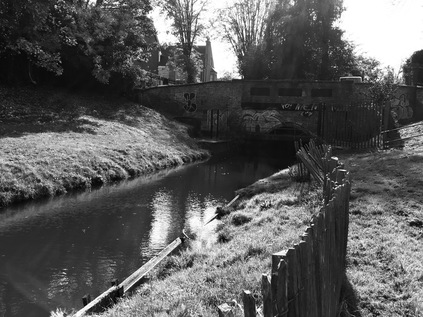
I emerged from a white-tiled underpass that carried the footpath under the railway lines, and suddenly found myself beside the river and walking just inches from the placid waters as they emerged from their own culvert. The path here was busier - not least because it formed a useful link to Hornsey High Street, passing a modern new development of homes which edged confidently up to the water and the squat brick-built pumping station, one of a number on this stretch carrying the dates of 1993 or 1994. I'd seen this development on my walk along the A504 and despite my natural objections to this form of encroachment on rivers, it still seemed like a reasonably well-thought-out development in a good location. The busy path ended at a typical New River Path kissing gate, and I just managed to skip through before the gent who had been bravely off-roading a pushchair along the bumpy ground ahead of me started trying to manhandle his contraption back onto the footpath. From my previous visit, I knew that the way was largely blocked here - the river passed under the railway via a modern concrete culvert, which carried it beneath the East Coast Mainline and along the edge of Hornsey Carriage Sidings. I needed to head along Turnpike Lane a little way, reprising a short stretch of my previous walk, before turning aside into Wightman Road. Confronted by a gentle but steady rise, I set out at a decent pace to conquer it painlessly and in the event managed to miss a turning which would have returned me to the river - if only briefly. In fact, Hampden Road was the scene of another of the encounters where I'd considered walking the New River in the past, while stalking across Harringey to find the remains of the Moselle during the heady Olympic summer while dodging discarded mattresses. Instead, I slogged on uphill through the suburban backstreets, with the river shadowing the fan of railway tracks below, until it entered a culvert carrying it under the road and into the back gardens of the Harringey Ladder. This section was also off-limits, the privacy of the locals being maintained by gates at each crossing. This stretch of the walk was a little dispiriting, with a sustained uphill slog to contend with and no easy sign of the waterway I was purportedly walking. Then, at the peak of Wightman Road, London opened before me. The tips of the towers of the City rose over the horizon, and the Shard speared the now clearing sky. Many times before I've written about walking towards London, but somehow this walk, from decidedly rural beginnings, felt genuinely like a walk into London. My feet were sore - but no more so than if I'd tried to rush one of the shorter walks I usually take - and so I pressed on, downhill towards a nasty snarl of a mini-roundabout where I needed to cross the street to get to Finsbury Park. The traffic was relentless, every opportunity to zip across scuppered by a thoughtless manoeuvre by a motorist. I almost despaired of the crossing and began rethinking routes - but persistence and a sudden window of opportunity caused by a white van driver stopping to shout at a driver he considered in error allowed me to cross and enter the park. The river resurfaced, pleasant paths and railings on each side. Here the noble purpose of supplying drinking water to the City was relegated and the visual amenity of a broad, clean waterway in a parkland setting was being vigorously promoted by the maps and signs around this corner of the huge park. I followed the river on its shaded side, crashing through piles of fallen leaves to walk close to the railing. The only hint of the true reason this fine waterway flowed through the park was a small, seemingly hand-lettered plaque affixed to the palisade near where an access road crossed. Finsbury Park rolled pleasantly off to the south and west, the near-endless green expanse busy with families enjoying the surprising autumn sunshine. I headed for the gate - there was still a way to go.
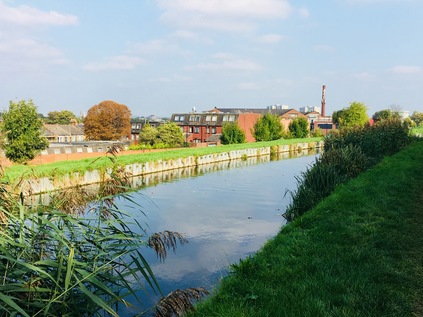
I crossed Green Lanes again and made swiftly for the adjacent gate to get back to the river path. Again this stretch wasn't unknown to me, cutting across several recent walks and curving sinuously east then west to enclose the pair of Stoke Newington Reservoirs near Woodberry Down. That said, I'd not walked directly alongside this stretch before, and I was keen to be alone on the path again after the long stretch of walking on pavements and busy roads. I was almost alone aside from some dedicated joggers who thudded by on the grassy path. Beside the path a screen of trees separated the northern section of the Woodberry Down estate from the river, this area has been largely untouched by the regeneration of the area so far. To the north of the water, the land fell away steeply to Eade Road and the Haringey Warehouse District, with the tall chimney of Maynard's sweet factory now proudly advertising the Oriental Carpet Company to the surrounding area. On the road below a police cordon was slung between lampposts and the river fence, a long stretch of the thoroughfare now off-limits. At the end of the cordon, a Police car blocked the street, its occupant leaning out of his door and enjoying the afternoon sunshine. The tenants of the nearby New River Studio complex seemed concerned enough to be bringing their outdoor seating indoors, looking worriedly back at the scene. The Police officer didn't share their urgency - he was clearly in this for the long haul, enjoying the chance to rest in a quiet industrial zone. My own quiet was disrupted by coming upon the Seven Sisters Road at a strange tangle of a crossing. Beyond the road, the river passed under an overhang of trees, before emerging at the eastern end of Woodberry Wetlands. Now fully open, this impressive conservation project which had returned wildlife to the fringes of the eastern reservoir and the riverbank seemed to be proving the critics of regeneration right. in the garden of the cafe - inevitably perhaps built from reclaimed shipping containers - a wine-laced reception was underway with lots of chortling and snorting, and lots of eager chatter about primary school places and OfSTED reports from the newly arrived and predominantly white inhabitants of the newly rising towers of Woodberry Down. Meanwhile, the path beside the river was pleasantly democratic - I weaved around a happily dawdling family of Orthodox Jews out for a stroll involving tricycles and scooters and negotiated a couple of animated West Indian men backslapping and mock-arguing their way along the river. The footpath changed from a rough riverside track to a carefully surfaced and sculpted 'river walk' winding needlessly to and fro along the bank, and the clientele changed too - cyclists with all the right gear but no warning bells, birdwatchers dressed like Bill Oddie when he really means business. The Wetlands had attracted crowds and were being enjoyed - but there was just the sense from the strolling new locals of Woodberry Down that they didn't really want the visitors here. This was their bit of London - bought and paid for, and we had no right to be enjoying the view across the reservoirs. The tall reed beds which had been allowed to encroach on the river signalled another shift - beyond this point, the New River has no official purpose. With roughly a third of the river's volume already decanted to the Coppermill Waterworks at Walthamstow, here the reservoirs are fed by the remaining flow and the last stretch is kept in water for entirely cosmetic purposes. Algae bloomed on the sluggish surface as walkers tramped by, harrumphing with dismay when I stopped to snap a picture back across the silvery sheets of water that stretched out towards Hackney. It was almost two years since I first stumbled into Woodberry Down unintentionally, and a great deal had changed. There was still a chance of course that this would settle down - that the new inhabitants would mesh with this longstanding community as London's incoming populations tend to over time. But as I crossed Lordship Road, there was a commotion of screaming and thudding. An angry and persistent voice raised in protest. A bunch of youngsters, clearly not perturbed by recent events in London ran towards the commotion. I slowed my pace - tried to decide how to proceed, carefully surveying the reactions of others up ahead. No-one stopped walking, no-one seemed bothered except to get a good look at what was going on. As I reached the roadside the boys who'd run to get a good view were coming back along the path. "It's OK" they reassured us all walking towards them, "It was just a bloke from one of the tower blocks up there going bonkers and shouting. The ambulance has come now." His crisis seems to stand for the strange tension in Woodberry Down on a hot October afternoon when no-one quite knows if they belong or not anymore.
I was back on Green Lanes, on the section where it suddenly seems quiet and insignificant after its long run in from the northern heights. The wide sweep of flat, green Clissold Park stretched out to the east, and a little too late I remembered that there was in fact a tiny isolated loop of the river's old course inside the park, stopped up and preserved for the sake of history. Instead, I pressed on south, to the junction with Petherton Road. This street bears perhaps some of the last significant above-ground evidence of the original course of the New River before reaching the city, with the impressive run of well-to-do homes and former shops divided by a central green space humped over the culvert which carried the river through respectably Canonbury. This area had long been a blank to me - a strange hinterland between the busy confusion of Highbury and the ancient mysteries of Hackney. It felt, on the surface, like a continuation of leafy Islington terraces, a pleasant walk between dog waste bins and creaky old benches, trying to stick to the narrow path which snaked along the centre of the park where the river used to run. At Canonbury Station, the Overground railway passed below, out-of-commission for the day for more works. Beyond the station, the Borough of Islington has tried hard to celebrate the New River, by way of a linear park with a winding approximation of the river at its heart. The park was surprisingly well-established, having been laid-out first in the 1950s and improved and maintained over the intervening years. This 'New River Walk' was busy with strollers too, all of us meandering along the banks of the shallow proxy of the river. A few students with visiting parents were evident, showing them how pleasant the area was and delivering a confusing version of the history of the river. I didn't mind too much - it seemed like a generally good thing that the river was remembered here, and it was strange how it seems so much more remarkable to those of us who didn't grow up with it at the foot of our gardens perhaps? The park was a cool, green haven from the surprisingly fierce sunshine of the late afternoon, with surprising fountains and hidden artworks providing unexpected interest along the way. Just when I was beginning to feel like perhaps this was just a bit too cleverly managed and inauthentic, and had little to do with the river which had once flowed here, the water took a broad meander around a circular brick watch house - the last remaining segment of the original course above ground in Islington. The scale of the achievement struck me again here - fresh water, conveyed entirely by gravity across the undulations of Middlesex and into the heart of London using Tudor technology and created by sheer effort of manpower. This tiny river, sometimes seemingly insignificant or forgotten on the journey, often flowing across other walks and routes which had always seemed so much more urgent or important for me to take, was a genuine wonder of London. I finally felt like I'd paid it some of the tribute it deserved by walking this far.
After crossing the upper reaches of drab but swiftly gentrifying Essex Road, I delved into the hinterlands again to find Colebrook Row. While no water flows here now, the route of the river which Charles and Mary Lamb's home overlooked is maintained as a stretch of green space running along the middle of the fine, Georgian terraces. Lamb wrote of his friend 'G.D' - possibly the radical poet George Dyer - walking apparently deliberately into the river to nearly meet his end by drowning. Lamb's horror and frustration at this 'self-destruction' is directed at the river - an unreal, unnatural channel which he regards as having none of the desirable qualities of a genuine watercourse:
Waters of Sir Hugh Middleton - what a spark you were like to have extinguished for ever! Your salubrious streams to this City, for now near two centuries, would hardly have atoned for what you were in a moment washing away. Mockery of a river - liquid artifice - wretched conduit! henceforth rank with canals, and sluggish aqueducts. Was it for this, that, smit in boyhood with the explorations of that Abyssinian traveller, I paced the vales of Amwell to explore your tributary springs, to trace your salutary waters sparkling through green Hertfordshire, and cultured Enfield parks? - Ye have no swans - no Naiads - no river God - or did the benevolent hoary aspect of my friend tempt ye to suck him in, that ye also might have the tutelary genius of your waters?
I was distracted myself here - either pondering Lamb, living here in horror at the river while fretfully protecting his matricidal sister from her own demons or perhaps trying to figure out which of the rather fine townhouses belonged to former mayor and BREXIT agitator Boris Johnson? In any case, I found myself suddenly and unceremoniously deposited on City Road in strikingly familiar surroundings near The Angel. My walk had almost ended, but I needed to push on just a little further to truly finish things. My feet felt heavy and inflexible but didn't hurt - I had perhaps passed that point some miles back - so I pressed onward, crossing the road and passing through Owen's Field and onto Roseberry Avenue. This small, private park bears a memorial to perhaps the last, and most destructive act of the New River. On 15th October 1940, the blast from a bomb-making a direct hit on the Dame Alice Owen School above fractured the pipeline carrying the river through Islington to its Clerkenwell terminus. The resulting flood engulfed the school's basement where 150 folk were sheltering from the air raid as they had many times before. With access to the surface blocked by the collapsed building, all of them perished in the deluge. This sombre ending to the walk was a reminder that conditions in London have always been hard, and that sometimes the very developments which are intended to improve and sustain the population can be unintentionally destructive in their own right. The best efforts to respond to the needs of a growing city can just as easily exclude, embitter and destroy. Planning for the future, for the unexpected developments of a city forever in flux, is an always essential task - though it seems at present to play second-fiddle for a sort of desperate opportunism. This is evident both in the endless towers of speculative 'luxury' developments creeping out of the ground along my route today and in the well-intended but poorly thought through schemes of the current Mayor.
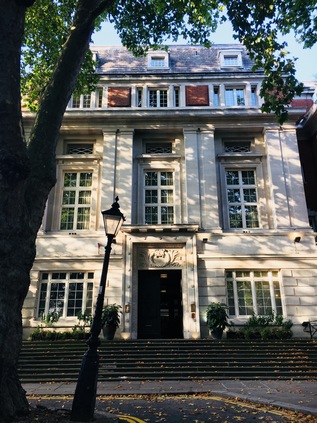
Finally at New River Head, the fringes of the city deserted as ever on a Sunday, I looked up at the grand former headquarters of the Metropolitan Water Board and the sleek modernist lines of the Laboratory Building beside it and figured that if unlikely schemes can be achieved anywhere in the world, London is probably the place. To bring fresh, clean water to this spot from distant Hertfordshire in a time when William Shakespeare - or the man who wrote the works attributed to him at least - was a living memory, was truly a remarkable feat. London changes, often not for the better, but is always remarkable. I shuffled off to find a way back to our hotel, wondering how my feet would feel in the cold light of tomorrow morning. I'd finally walked the New River as I'd long-promised - and the river had raised questions and new routes to walk along its entire length.
You can find a gallery with more images from the walk here.
Lost::MikeGTN
I've had a home on the web for more years than I care to remember, and a few kind souls persuade me it's worth persisting with keeping it updated. This current incarnation of the site is centred around the blog posts which began back in 1999 as 'the daylog' and continued through my travels and tribulations during the following years.
I don't get out and about nearly as much these days, but I do try to record significant events and trips for posterity. You may also have arrived here by following the trail to my former music blog Songs Heard On Fast Trains. That content is preserved here too.
